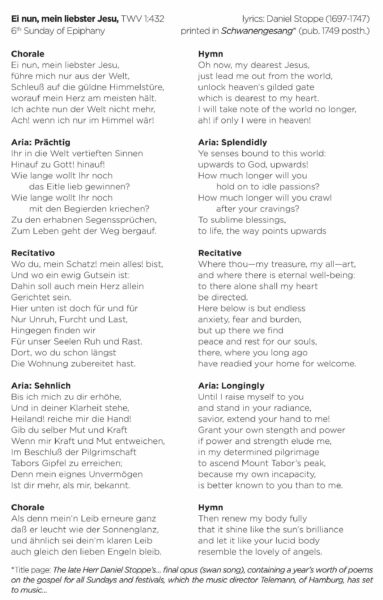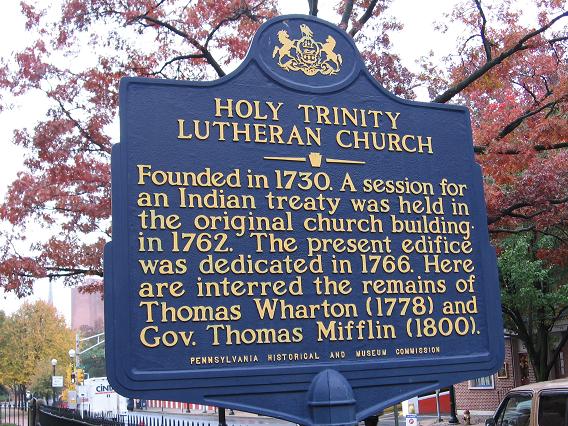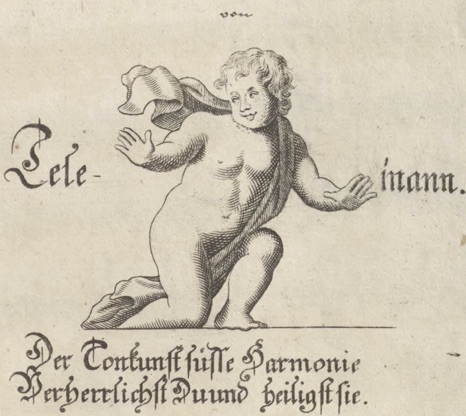Tonight’s The Faithful Music Master program at the American Philosophical Society in Old City (8:00, 427 Chestnut Street) is devoted to Telemann’s instrumental chamber music, with works that span the period he devoted to the genre, ca. 1700–1740. But mezzo-soprano Meg Bragle will also sing a church cantata with a special connection to Colonial Pennsylvania.
An article by Marc-Roderich Pfau in the Bulletin of the International Telemann Society, “Telemann in the New World: a church dedication in Lancaster, Pennsylvania, 1766”* drew our attention to the fact that Telemann got performed in the American Colonies during the composer’s lifetime.
A German organ builder sailed to America with some Telemann cantatas, up the Delaware River, into the Port of Philadelphia, then out via the Lancaster Pike to Lancaster. It was at the dedication of Holy Trinity Lutheran Church in 1766 that an aria from Telemann’s cantata, Ei nun, mein liebster Jesu, TWV 1:432 was performed, along with some other Telemann devotional music.
We performed the full cantata at Holy Trinity in Lancaster a couple of weeks ago. The experience was a bit of a spine-tingler to say the least. How often do you get to give what’s possibly the modern premiere of a piece of European music here that had already been played in America during the baroque era?
“Ei nun” comes from Telemann’s last published cantata cycle, the so-called “Angel” Cycle (Engeljahrgang), 1748–1749, named for the picture of an angel on the cover separating the first four letters of “Telemann” from the last.
We’d begun corresponding with Dr. Pfau, and after he heard the radio stream over The Classical Network, WWFM, of our September performance of Faithful Music Master, he revealed that he’s also a theologian and gave us an enthusiastic take on the cantata text. I asked and he gave permission to share that with our readers. I’ll also include the cantata text itself.
The translation is mine, and therefore a bit rough and literal, but you’ll get it.
My favorite piece is, however—yes I am also a theologian—the cantata from the “Angel” cycle (Engeljahrgang). The first aria in particular is thoroughly wonderful.
The cantata interprets Matthew 17:1–9, the story of Jesus’s transfiguration, which traditionally takes place on Tabor Mount (cf. second aria). That’s where the motto, “upwards (first aria: hinauf) with Jesus!” comes from. The ascent up the mountain is analogous to mankind’s journey to heaven.
The recitative takes the words of Peter: “[Lord,] it is good to be here,” when he says he wishes to build tabernacles. The eternal dwelling however is the one that Jesus has prepared.
The second aria references the transfiguration of Jesus, which transfiguration for Christians is anticipated upon death: til I also “stand in thy glory.”
The chorale alludes again that Jesus would be bodily transfigured, “like unto thy glorified flesh.”
That you have sought out this cantata also therefore especially nice, because there are no Bach cantatas for the third Sunday after Epiphany, nor have there been any performances on CD for that Sunday by Telemann, Graupner, Stölzel and so forth.
Before I drop in the cantata’s lyrics, which Ulrike helped with and therefore should be pretty good, I recommend you look at a little list in McSweeny’s for a good giggle, “Titles of Bach Chorales, as Translated By My Niece After One Semester of German.”

The translation above comes from the Telemann 360° program book.


